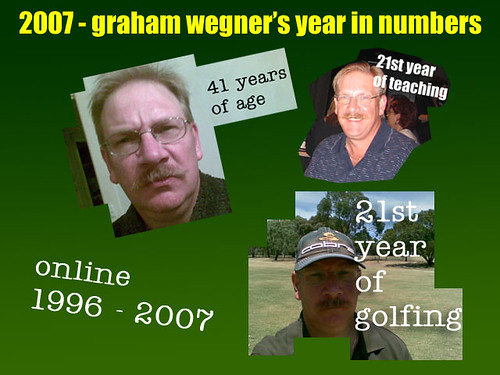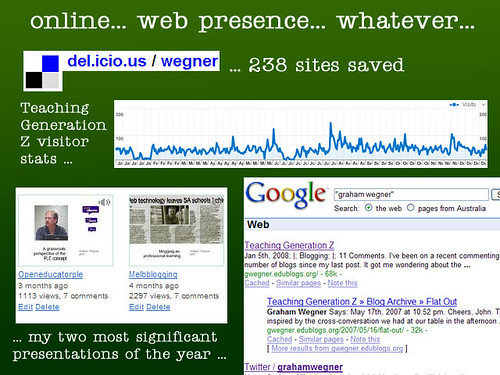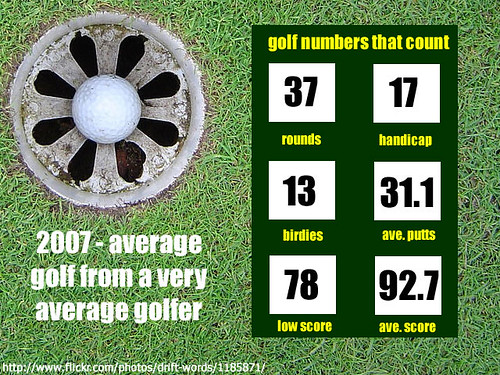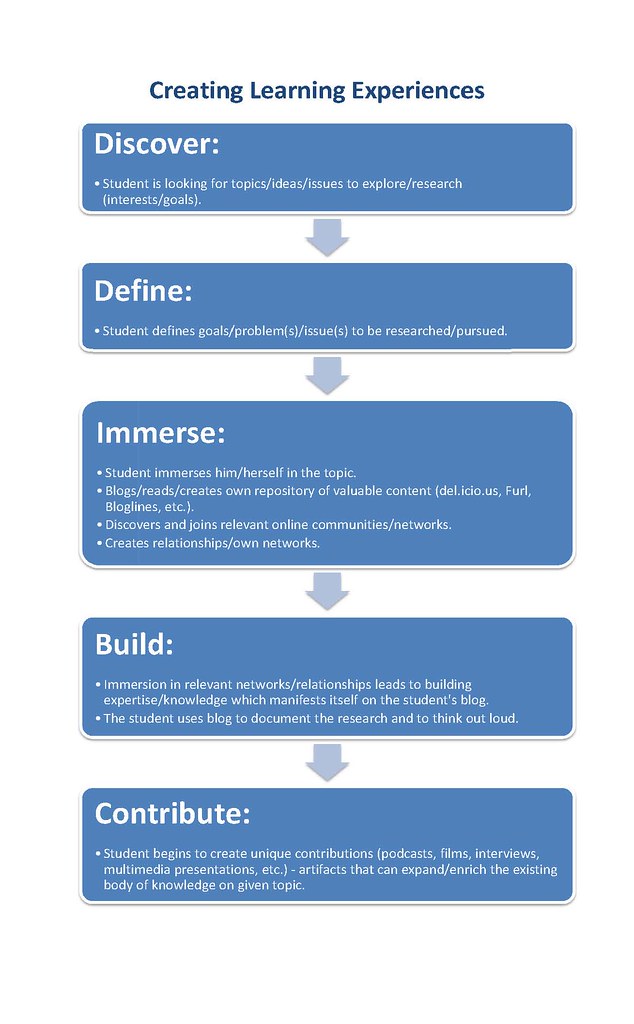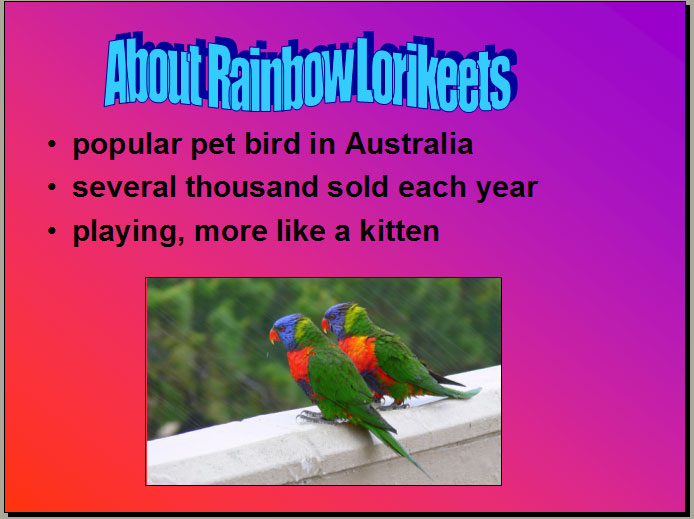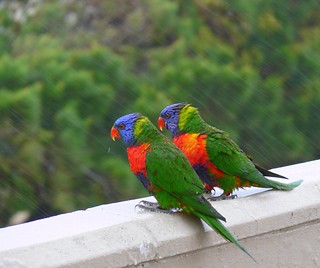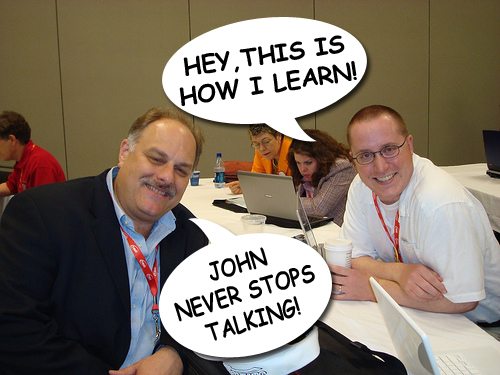I learn most when I'm challenged to justify or explain the rationale behind my classroom practice and the choices about the tasks I set for my class. The challenge can come in the form of a blog post that questions, a comment response that draws assumptions or a reflective research tool that has me watching a DVD of one of my lessons and coding it according to researched guidelines. And as a learner, I don't always come with a satisfactory answer but every challenge helps.
I've used inquiry research projects in my classrooms for over ten years now - initially when it was called Resource Based Learning, then rebadged as Problem Based Learning when I moved to my current school and now referred to as the inquiry approach. I've used models including McKenzie's Research Cycle, our local TSOF (RIP) model then to the recent work in this area by Kath Murdoch. Ten years ago when I team taught with one of the most innovative (and influential) teachers I've come across, we both developed the rationale that inquiry work (RBL was our name at the time) was great in terms of allowing students choice and control in their learning but adding the final presentation in front of their peers added another layer of purpose to their work. We both trialled webquests with our classes in and around 1999/2000 but found that the process was too scripted and the reliance on Web-only resources to be too restrictive.
Students would do their own RBL topics - sometimes it was glorious success (I recall a 1997 presentation on The Wolf by a Year Six girl where she role played a wolf, had her best friend read scripted questions as a news reporter and the research findings flowed from this fictional interview) or dismal failure. An unmotivated student back in 1999 simply drew a lopsided pyramid on the white board in texta and trotted his theories about aliens constructing the pyramids. And the class was so well versed in the art of positive feedback and constructive criticism (my diplomatic nature coming to the fore) that after the silence that ensued, the first comment was, "I really like your pyramid drawing."
Of course, the use of the internet has been a boon to this form of learning as the students are not just limited to what the school library has in stock. Which also means the issue of teaching effective digital literacy skills becomes of utmost importance. So, the final presentation became a purpose for all of the questions and answers. It was superior to handing in something to the teacher because the audience expanded to their classroom colleagues. The presentations started to evolve as the technology at the students' disposal became easier to utilise. We went from student prepared overheads to handouts to designed displays then to booking the computing room so that the data projector could be utilised. With the move to a new school, it seemed the inquiry learning approach was a low priority and it has been part of my role to infuse it into teachers' practices - with varying success.
With the advent of interactive whiteboards in the school and a very inspiring session as part of our Middle Schooling cluster, I began the idea of Personal Research Projects with my class where the students could research a topic of their choice that would be geared towards a peer presentation. This started last year when I combed the SACSA S.O.S.E outcomes tracking general topics as a starting point and the inquiry process was combined with a student initiated approach.. Students could make a choice about their topic and their research process was then geared towards a final presentation to their classmates. Then this year under the guiding principles of our recently Middle Years Learning Unit vision which has the development of student initiative as one of its desired outcomes. To that end, the Personal Research Projects (renamed as to not be confused with the IB version of Personal Projects which has a very different focus) were introduced for all four of the MYLU classes with the general choices of (a) your own choice, (b) something new and (c) something from the wider world spread over terms two to four.
I've already blogged about the Term Two projects from my room so my original intent was a quick update on my students' start to this term. There was some professional disagreement around our learning team table about how to structure and start the Term Three theme of something new. As my role includes leading out in any area to do with information literacy, I devised a student driven way to determine new topics. With my class, I discussed the idea that for something to be really new, you would to need to barely know anything about the topic and in fact, you might not even know that it exists. So here's what we did.
Every student had a sheet of paper and I decided that this term I would join in the process and produce a Personal Research Project of my own. On this paper, each student wrote down topics that they had covered in the past then we rotated the papers around the room. In 30 second bursts, each student would suggest a new topic for their peer from a broad list of categories we brainstormed up on the interactive whiteboard. There's a bit of pressure involved to get something down so not all suggestions were inspired but it was very interesting to see what did get on the list and considering there were 30 kids trying to produce 30 unique topic lists (that's 900 potentially unique topics!) it went pretty well.
[My list - basketball, sport, orchestra instruments, soccer, transport, football, Malaysian food, squash, air dynamics, planes, ice hockey, cats, cricket, ancient foods, our school, tennis, movie directing, swimming, sewing, golf, the Great Wall of China, Who invented the clock?, Fashions of the 80's.]
The students then narrowed down their possibilities to two or three that looked interesting. You can see mine are bold underlined. Armed with their final choice, we headed to the computing room where the students used Quintura and Kartoo to generate key word mind map diagrams to assist with the start of their research. See these diagrams as an example of how the key words were generated by the visual search engines.
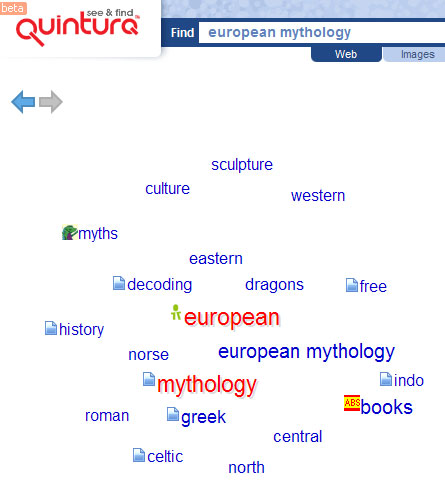

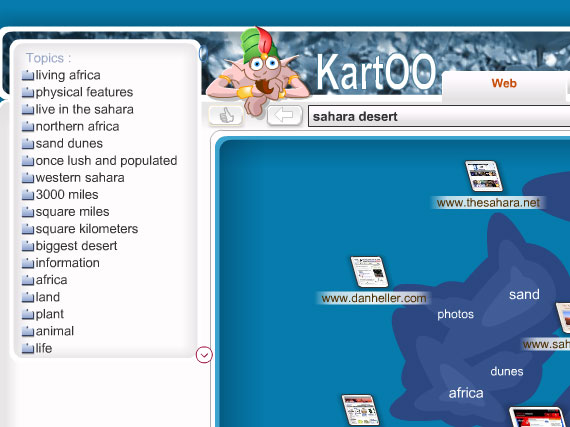

So I think that my kids are off to a good start. But as I wrote earlier, there was not consensus about this approach when I introduced it to my learning team colleagues. Riding on last term's success and buoyed by the fact that the students had developed some promising research and presentation skills and were highly motivated by the control they had over their work, I was surprised that some of the team wanted more say in what the students in their classes would be working on. Their point of view that something new could be decided upon by the teacher because that choice would in fact be new, and they would allocate choices within that topic. It was hard to argue against because their choice was to look at charities and community programs (Guide Dogs, Amnesty, Doctors Without Borders etc.) and that is a worthwhile thing for students to be looking at. I suppose I felt (as did my planning partner) that the student initiated component is too important to disregarded. Sure, if one of my students wanted to investigate a charitable organisation, fine, but for me the process of investigation and questioning and constructing learning with a purpose in mind is more important than all kids being "guided" into a defined area of focus. Another example that not all teachers see things in a particular way or necessarily value different aspects and approaches in equal ways.
Anyway, to wind this post up, I have stated before that I was particularly impressed with the presentation process and that consideration was given to audience needs in their accompanying slides. I emphasised the "more is less" approach which is exactly some of the advice being offered by Dan Meyer in some of his great posts on slide design. I wandered into Christian Long's blog post where he was exploring aspects of one of Dan's more recent posts - it seems I've been commenting there a fair bit this week. I used his general theme of innovative use of slides in the classroom to expand on why I think my students' presentations were a great learning experience.
....the lense with which I want to examine your take comes from my own classroom and our "Personal Research Projects" program that I have led out alongside our middle school teachers. Using an inquiry-centred learning approach, my students developed presentations on a topic of their own choice over the course of two months. I blogged about the process recently so I won't go through the details here but I tended to err on the side of guidance rather than requirements. I wanted the students to find their own way through, be open to advice and be prepared to have their presentation critiqued by their peers. So I know that when you describe the "Death by Powerpoint" presentation classroom, it's not mine and I dare say there are many teachers like me where the end product is just the start of the conversation. With my students, we negotiated together what we believed good presentations to be about. We designed a rubric that the kids themselves would use during the presentations. I talked about the slides complementing their research, that clear well chosen images convey meaning that excessive text cannot, the importance of considering your audience's needs and how eye contact conveys respect to your audience.
You ask in your post "...are they really demonstrating anything that resembles learning?"
My oath, they were.
Yes, Powerpoint was the choice of every student (but not mandated by me) and as they watched each presentation, the learning was there in masses. It was there in the feedback that the students gave each other, scaffolded initially by me, but when students say comments like, "I wasn't interested in Roman History before your presentation but now I want to know more", it's paydirt. It happens when the students who can't resist the call of the animated bullet points, clicking through them furiously because they've just realised they don't add anything to their message. It happens when a student proclaims an animé drawing as their own work scanned into a slide but someone eagle eyed spots the plagiarism via a watermarked URL on the corner of the slide. It happens when a well intentioned student's presentation goes over the twenty minute mark because they didn't want to leave anything out only to realise that they've lost the interest of the class. Done tactfully, which is where teacher guidance is crucial, the conversation emanating from these presentations has initiated and cemented learning about the research process, the importance of citing sources, catering for your audience's learning needs and yes, learning that "less is more" when it comes to conveying meaning, ideas and information across to your peers.
Christian then reminded me of the importance of constraints (and maybe that's where my differing learning team colleagues reside in their thinking.)
The passion and intentionality of your approach with using PPt with your kids is to be commended on many levels. Best of all is your conviction that the 'process' itself was more powerful than the end result, and by process I mean in 'review' as much as in 'creation.'
Like you, Dan's posts/ruminations on the power of good design in teacher work has also compelled me to be far more intentional when working with PPt, etc. His expertise and passion for design/presentation may define his role in the larger edu-blogosphere for some time to come (in addition to his clear math'pertise).
All I will add to your original comment is that while 'process' is vital (and the 'discovery' that comes with it), the clear 'constraints' we put on the project offer significant value as well (and 'challenge'). If our kids think always in terms of audience (both in and out of the class, regardless of 'grades'), then the 'constraints' are tied to the audience's needs and willingness to pay attention/care. Yes, we want kids to co-create the process, but we also want them to know WHY they are doing what they are doing...and constraints give us a place to push against, as opposed to limits.
And I while I am sure that my process had its constraints in place, his point to me means that clearly documenting and justifying the purpose of the project is as crucial as allowing the students freedom to explore what they see as interesting and important. Especially at this age (10 -12 year olds) their first taste of choice based learning can be a heady experience and not everyone bounces back easily from a rocky landing if they get their process wrong, burn time chasing unimportant details or misread my verbal suggestions. Cushioning in terms of clear written guidelines, explicit demonstrations of process and regular reviews of progress will give every student a shot at the glowing feedback and satisfaction of an attentive and interested audience.
It would be great if the choice quote of last term's presentations became commonplace.
"I wasn't interested at all in Roman History but your presentation has made me want to find out more."
Year 6 female student offering verbal feedback to Year 5 male student, Term 2, 2007.

